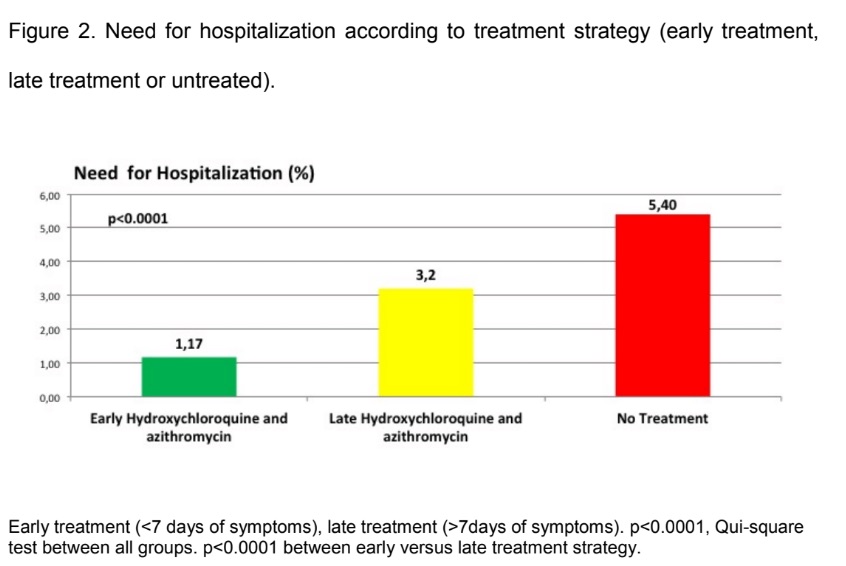SOURCE: Covexit
The advanced copy of a new study, by Rodrigo Barbosa Esper M.D., Ph.D. and collaborators has just been circulated. The study analyzes the effects of hydroxychloroquine and azithromycin treatment, via telemedicine, can reduce the need for hospitalization.
This is the first of several articles that will be published in relation to the study of 636 outpatients – 224 of them having refused the treatment and were used as a control group. 412 patients were treated with the two drugs.
Here are key highlights of the just released study. The abstract follows, and so does the .pdf file of the study titled “Empirical treatment with hydroxychloroquine and azithromycin for suspected cases of COVID-19 followed-up by telemedicine.”
Patients enrolled in the study were residents of the city of Sao Paulo, Brazil, after the pandemic was officially declared in this city.
Consecutive outpatients with persistent flu-like symptoms (suspected COVID- 19 infection), persisting for a period equal to or greater than 2 days, were first evaluated by the telemedicine team or by the emergency department medical doctor. All physicians had access to medical records of all subjects, such as clinical history, laboratory parameters, images exams and electrocardiograms.
Those who had no immediate need for hospitalization and no contraindications for treatment were invited to participate in the study. Treatment with hydroxychloroquine associated with azithromycin was suggested and prescribed if consented from patient.
For this study, inclusion criteria were Patient over 18 years old and flu-like persistent symptoms > 3 days, with a probable diagnosis of COVID-19 and no immediate indication for hospitalization. Exclusion criteria severe related retinopathy; severe liver disease; Myasthenia Gravis; Known QT enlargement; Pregnant; Severe renal failure.
In case patients needed to be referred to hospital, they were evaluated, admitted and treated by medical staff advised to follow the standard protocol from the institution. The main hospitalization admission criteria were: Worsening general condition, or Oxygen Saturation < 90%.
The treatment protocol was Hydroxychloroquine 800mg on the first day and 400mg for another 6 days and azithromycin 500mg once daily for five days.
The telemedicine team followed 636 consecutive outpatients who had flu-like symptoms and could be monitored. Of these, 224 patients (35.2%) refused the proposed treatment, making up the control group; 412 (64.7%) consented to start treatment with hydroxychloroquine and azithromycin.
The authors “observed that early evaluation of suspected COVID-19 patients by telemedicine associated with empirical treatment with hydroxychloroquine and azithromycin is an important strategy that may prevent hospitalization.”
Patients treated with hydroxychloroquine and azithromycin compared to untreated patients had 2.8-fold lower need for hospitalization.
In addition, need for hospitalization in patients treated before versus after the 7th day of symptoms were … 4.6x lower rate of hospitalization compared to untreated patients.
Patients hospitalized with severe COVID-19 have laboratory evidence of an exuberant inflammatory response, also described as “cytokine storm” with persistent fever, elevated inflammatory markers and proinflammatory cytokines (interleukin-6 [IL-6], D-dimer, ferritin, troponin).
The study stresses that telemedicine “can effectively provides patient’s care, reduce emergency unit overcrowding and promotes social isolation, which in turn is not only favorable to prevent the spread of infection in the population, but also among health professionals.”
Regarding side-effects, there is what the authors have to say:
“In our study, we did not observe any severe side effects related to treatment. A systematic review analyzed the safety of chloroquine treatment for uncomplicated malaria identified three trials (n=1039) that provided sufficient data on adverse events.
Non-serious adverse events, such as vomiting, nausea, headache and abdominal pain, were the most commonly reported and only two cases were considered serious (maculopapular rash and severe pruritus). None of the patients required hospitalization.”
The study conclusion reads as follows:
“According to our study, empirical treatment with hydroxychloroquine associated with azithromycin for suspected cases of COVID-19 infection reduces the need for hospitalization.”
Read the article here: http://covexit.com/new-brazilian-study-shows-telemedicine-hydroxychloroquine-treatment-reduce-need-for-hospitalization/
Refer to the PDF here: http://covexit.com/wp-content/uploads/2020/04/New-Brazilian-Study-Shows-Telemedicine-Hydroxychloroquine-Treatment

